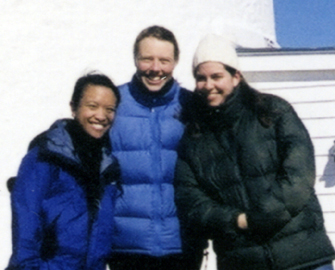|
Web
Exclusives:Features
By A. Melissa Kiser '75 Photo: Last fall, Greene, Newell, and Lantin produced an educational video. Early in medical school at the University of Pennsylvania, Kim Newell '94 heard an emergency room physician tell a 19-year-old female patient who had recently emigrated from Haiti that he was concerned that she might have HIV. The patient, who had complained of fatigue and occasional dizziness, had no other symptoms beyond a fever and a low platelet count. Fearful, she asked the doctor what would happen if the HIV test were positive; he responded matter-of-factly: "You will die." The patient refused the test and left the ER. Newell found herself wondering: If the patient had been a friend of the physician, would the doctor have had the same suspicion of HIV? Would he have answered his friend's questions in the same brusque manner? In this case and some others, she recognized that something was creating boundaries between doctor and patient and asked herself, "Is it culture? Is it race? Is it class?" When Newell returned to Princeton for her fifth reunion, she reconnected with Jennie Greene '94, who was pursuing a master's degree in health and social behavior at the Harvard School of Public Health. Each had just finished reading the same book chronicling the tragically ineffective efforts of doctors to work with an immigrant family in treating their seriously ill child, and their conversation at Reunions revealed a shared interest in what Newell calls the "invisible wall between patient and medical professionals" when their communication crosses racial and ethnic lines. Subsequent discussions and research led them to collaborate on an educational video that would help the medical community better understand the issue of cross-cultural communication. They enlisted Mary Lantin '94, also a student at the Harvard School of Public Health, to help with strategy and funding. The Harvard Center for Cancer Prevention provided both sponsorship and a specific focus for their yearlong study. Specializing in communication about cancer was appropriate, Greene points out, because "certain populations have higher rates of cancer." Newell joined Greene in Boston, where they conducted interviews and focus groups, often using interpreters. One interpreter observes that patients and health care providers from different cultures "have different beliefs, different systems. And sometimes when I'm interpreting perfectly well, I'm saying everything that's being said, they don't connect. There's something that's missing, which is the cultural part." The nonprofit video they produced, Community Voices: Exploring
Cross-Cultural Care through Cancer, uses real people discussing
their own experiences. Released in the fall of 2001 for use in medical
schools, hospitals and health systems, and community-based organizations,
it explores the potential for misunderstanding between medical providers
and patients from various Asian, Middle-Eastern, and Hispanic cultures,
as well as from African-American and Appalachian backgrounds. By A. Melissa Kiser '75 A. Melissa Kiser is public relations officer at The Pennington School.
|

 March
27, 2002:
March
27, 2002: